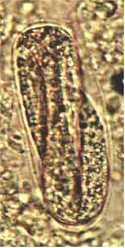Metastrongylus is a genus of parasitic roundworms that infects mainly pigs and wild boars worldwide. Prevalence in wild boars may be very high.
that infects mainly pigs and wild boars worldwide. Prevalence in wild boars may be very high.
Studies in Central Europe found populations of wild boars that were 100% infected with these worms.
There are several species of veterinary importance, all with a similar biology and life cycle:
- Metastrongylus elongatus (= Metastrongylus apri). The swine (hog, pig) lungworm. Infects swine and wild boars, very occasionally also dogs, cattle, sheep, deer and even humans.
- Metastrongylus salmi. Infects swine and wild boars.
- Metastrongylus pudendodectus. Infects swine and wild boars.
Mixed infections are frequent, i.e. the simultaneous presence of several Metastrongylus species in the same host.
The disease caused by Metastrongylus lungworms is called metastrongylosis.
Are pigs or other animals infected with Metastrongylus worms contagious for humans?
- NO. The main reason is that eggs shed with the feces of infected animals are not immediately infective, but need to be ingested by intermediate hosts (earthworms) before becoming infective for humans or whatever mammal. For additional information read the chapter below on the life cycle.
You can find additional information in this site on the general biology of parasitic worms <and/or roundworms.
Final location of Metastrongylus
Predilection sites of adult Metastrongylus worms are the bronchi and the bronchioles, Metastrongylus elongatus also in the trachea.
Anatomy of Metastrongylus
Adult Metastrongylus are slender worms, 2 to 5 cm long and have a whitish to yellowish color. Females are about twice as long as males. As other roundworms, the body of Metastrongylus worms is covered with a cuticle, which is flexible but rather tough. The worms have no external signs of segmentation. They have a tubular digestive system with two openings.
They also have a nervous system but no excretory organs and no circulatory system, i.e. neither a heart nor blood vessels. Males have long and slender spicules for attaching to the female during copulation.
The eggs are ovoid, measure about 50x60 micrometers, have a thick shell, and contain a fully developed L1-larva when shed.
Life cycle of Metastrongylus

Metastrongylus lungworms have an indirect life cycle with pigs and wild boars as most usual final hosts, and earthworms as obligate intermediate hosts.
Adult females lay eggs already embryonated in the airways of the final host. These eggs are shed to the mouth through coughing and sneezing, and most are swallowed and passed with the feces. Once in the soil, if it is humid enough, some eggs will hatch and release L1 larvae that can survive for up to one year by appropriate climatic conditions.
Most larvae are quickly ingested by earthworms (e.g. of the genera Lombricus, Eisenia, Helodrilus, etc.) where they continue development to infective L3-larvae in about 10 days. These worms can remain infective for years. Pigs and wild boars become infected after ingesting such contaminated earthworms.
The L3-larvae are released in the host's stomach, burrow through the gut's wall, reach the lymphatic system or the blood stream and are carried to the heart and the lungs, where they complete their development to adult worms, mostly in the bronchioles, bronchi or trachea.
The time between infection and first egg shedding (prepatent period) is 2 to 4 weeks.
Harm caused by Metastrongylus, symptoms and diagnosis
Metastrongylus lungworms are usually not a problem in industrial pig farming under confined conditions. It can occur in pigs kept outdoors and in traditional farming, especially if they share part of their environment with wild boars.
Metastrongylus infections are usually benign and with no clinical signs or only mild ones in adult pigs. Wild boars can support several hundred worms, apparently without any significant harm. It seems that pigs can also develop a certain natural immunity to these worms. Piglets and young pigs are however more likely to develop the disease. Massive infections can cause bronchitis (so-called verminous bronchitis) and pneumonia, with cough and nasal discharge as major signs, leading also reduce weight gains.
Other respiratory complications can develop due to secondary infections. It seems unlikely that these worms are associated with the transmission of swine influenza and hog cholera, but it has not been definitely ruled out.
Diagnosis is based on clinical signs and is confirmed by detection of eggs in the feces, although egg shedding is often rather low (~200 eggs/g feces).
Prevention and control of Metastrongylus
Animals younger than 6 months are more likely to suffer from infections with Metastrongylus worms. As already mentioned, pigs kept outdoors are most at risk of becoming infected. It is often difficult to prevent them eating earthworms. One option is to keep young animals on hard floors (concrete, wood, etc.), especially during the rainy season. Another option is to put them nose rings to prevent them rooting.
Numerous dewormers are effective against Metastrongylus adults in pigs, e.g. several benzimidazoles (albendazole, fenbendazole, oxfendazole, etc.), levamisole, as well as several macrocyclic lactones (e.g. abamectin, doramectin, ivermectin, moxidectin), the latter are also effective against migrating larvae.
Depending on the country they are available for oral administration (mainly as feed additives) and/or for topical administration as pour-ons. Levamisole and most macrocyclic lactones are usually also available as injectables.
There are so far no true vaccines against Metastrongylus lungworms, neither for pigs, nor for any other mammal. To learn more about vaccines against parasites of livestock and pets cclick here.
Biological control of Metastrongylus lungworms (i.e. using its natural enemies) is so far not feasible. Learn more about biological control of worms.
You may be interested in an article in this site on medicinal plants against external and internal parasites.
Resistance of Metastrongylus to anthelmintics
So far there are no reports on resistance of Metastrongylus lungworms to anthelmintics.
This means that if an anthelmintic fails to achieve the expected efficacy, chance is very high that it was not due to resistance but to incorrect use, or the product was unsuited for the control of Metastrongylus lungworms. Incorrect use is the most frequent cause of failure of antiparasitic drugs.
Learn more about parasite resistance and how it develops.
|
Ask your veterinary doctor! If available, follow more specific national or regional recommendations for Metastrongylus control. |